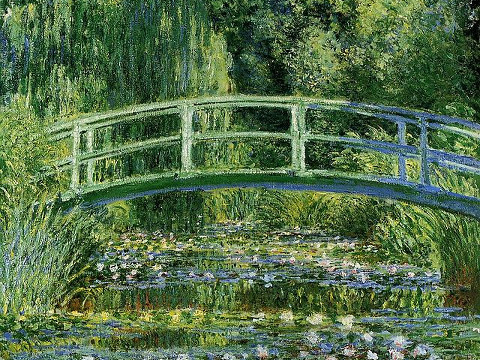
Claude Monet is my favorite painter. I like his bright, subdued scenes because they evoke a sense of calm, tranquility, and natural beauty. Monet was part of the Impressionist movement in art, which included other now-famous names such as Degas, Manet, Pissaro, Cassatt, Cezanne, and Renoir. Most were contemporaries of each other and worked in the late 19th century.
One of the more fascinating things about the Impressionists is their connection to photography. At that time, photography was just emerging as a new way to document and preserve images. Up to that point, artists and their renderings were the only way to preserve an image of a famous person, scene, or landscape. Most artists, then, were highly trained in the realistic portrayal of these things, and while specific styles such as the Renaissance, Baroque, Rococo, and Romantic ebbed and flowed in significance, their common trait is that they were largely realistic interpretations of people, scenes, and landscapes.
Photography changed art because it provided a new way to preserve images. Artists such as the Impressionists, and all those since, have had to work to differentiate themselves from photography, and, now, videography. As one of the first groups of painters to respond to photography, the Impressionists adapted their work in two fascinating ways. First, they focused on the overall impression of colors rather than strict adherence to lines and contours of the past. Photographs at that time were black and white, so color became a unique way for the Impressionists to express themselves. Secondly, the Impressionists took their work outdoors, to capture people, scenes, and landscapes more directly. Up to that point, most artists worked in a studio of some kind, but the Impressionists wanted to capture more transient, fleeting moments than studio painting could afford.
I’ve been thinking about how we’re witnessing a similar shift in coaching across sports. Whereas photography was the great leveling force for the visual arts, statistics and the overall prevalence of instant technology, including instant analysis and reaction via social media and the 24-hours news cycle, is what is changing the modern dynamic of coaching in sports.
Previous to the modern analytics movement and its convergence with social media and the 24-hour news cycle, coaches could rely on hunches and gut feelings and get away with it if they were successful. Now, every sport has sophisticated statistical measures that cut open and reveal if these hunches are right or wrong. Just like in any profession, coaches mostly develop their sense of the game from participating in the sport for many years. This body of wisdom becomes a storehouse from which the coach makes decisions.
But now with the convergence of analytics and social media, two other components have emerged that further impact modern coaching: the rise in power of the individual star athlete and the dedicated business of sports analytics. Contemporary athletes are brands. Their celebrity is matched by few, and their rise in prominence, fame, and wealth gives them much more power with coaches, management, ownership, and fans than they did in the past. Similarly, while there have always been people interested in the statistics of each game, there has only now emerged an entire industry, from the business end to the popular end, that specializes in providing data and analyzing and interpreting its meaning for each sport. Analytics is no longer a subgroup of sports fans, but is a driving force at every level of professional sports.
Coaches have had to adapt to this new world, much like the Impressionists did in the 19th century, by becoming skilled in two key areas: motivation and data synthesis. Let’s assume that most coaches across sports have a general understanding of their sport and also know the nuances of the game more than the average person. What makes them stand out, though?
Modern coaches are adept at building relationships with players and finding ways to motivate specific individuals. Gregg Popovich of the San Antonio Spurs is the most successful current coach in the NBA, and while many see him as an eccentric strategist, he is most adept at taking an international roster and motivating each of them individually to achieve a complete team mindset. Similarly, Bill Belichick is viewed like a mad scientist of sorts, but he is masterful at using military history as a motivational tool to inspire his players.
Coaches stand in the gap between the modern sports athlete, with all the power, wealth and fame that entails, and the vast amounts of data and analysis on player performance. The best are able to synthesize the data by picking the most relevant and important pieces from the overabundance and translate its significance and meaning to their players. At its core, this ability to synthesize is comparable to being really good at listening.
Effective communication, which is at the heart of any relationship of significance, is predicated on listening. But it is where we break down so often. I love how the ancient Hebrew word “shema”, found at the beginning of Deuteronomy 6:4, has a double meaning of “hear” and “obey”. We tend to view listening as passive, but it is really an active process. It’s often been noted that we have two ears but only one mouth. We could all learn to listen just a little bit better.













